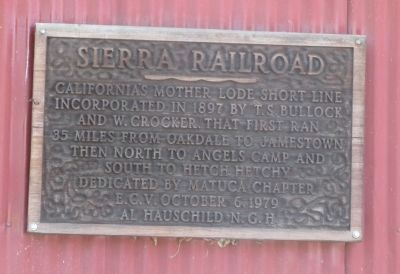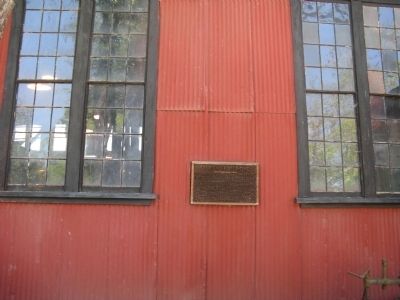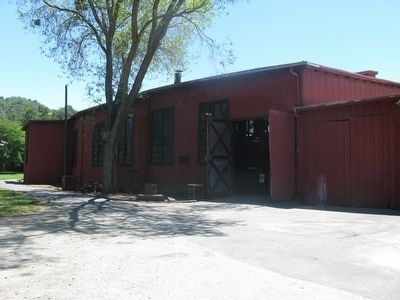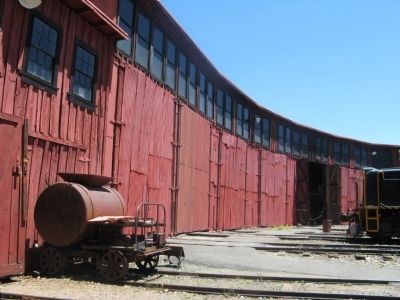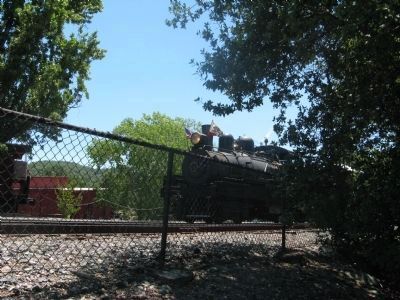Jamestown in Tuolumne County, California — The American West (Pacific Coastal)
Sierra Railroad
California’s Mother Lode short line
Incorporated in 1897 by T.S. Bullock and W. Crocker. That first ran
35 miles from Oakdale to Jamestown
then north to Angels Camp and
south to Hetch-Hetchy.
Erected 1979 by Matuca Chapter E Clampus Vitus.
Topics and series. This historical marker is listed in this topic list: Railroads & Streetcars. In addition, it is included in the E Clampus Vitus series list. A significant historical year for this entry is 1897.
Location. 37° 57.027′ N, 120° 25.021′ W. Marker is in Jamestown, California, in Tuolumne County. Marker can be reached from Sierra Avenue near 9th Street. Marker is mounted on the wall of the Roundhouse at the Railtown 1897 State Historic Park. The park may be reached off of Highway 49/108 via 5th Street. Touch for map. Marker is in this post office area: Jamestown CA 95327, United States of America. Touch for directions.
Other nearby markers. At least 8 other markers are within walking distance of this marker. “Railtown 1897” (within shouting distance of this marker); Sierra Railway Shops (about 500 feet away, measured in a direct line); Jamestown United Methodist Church (approx. 0.3 miles away); St. James Church (approx. 0.3 miles away); National Hotel (approx. 0.4 miles away); Ramirez – Preston Building (approx. 0.4 miles away); The Emporium – 1897 (approx. 0.4 miles away); Jamestown (approx. 0.4 miles away). Touch for a list and map of all markers in Jamestown.
More about this marker. This is a fee use site and the marker is located inside of the park area.
See Nearby Marker "Railtown 1897" for additional information.
Regarding Sierra Railroad.
Incorporated on January 1, 1897, the Sierra Railway Company was the brainchild of Midwesterner Thomas Bullock. Bullock and his fellow investors – San Francisco banker William Crocker, Crocker’s brother-in-law Prince Andre Poniatowski, and others – had mining interests in the area. The development of a short-line railroad from Oakdale could replace horse-drawn wagons to bring lumber and mining materials to the growing Sacramento and San Francisco areas.
Bullock had owned a failed railroad venture in Arizona that left him with three steam locomotives and several miles of rail. With the addition of 15 new freight cars, the Sierra Railway was soon moving U.S. mail, passengers and freight.
The Sierra Railway Company also established working relationships with the Southern Pacific Railroad Company and several stage lines to serve mining, lumber and agriculture interests. However, as the costs of gold mining increased with the onset of World War I, the Railway’s profits decreased. Even worse, trucking companies had begun competing with trains.
During the Great Depression, the Sierra Railway Company went into receivership, a form of bankruptcy in which the company is allowed to reorganize without losing the value of its property. On April 1, 1937, it was renamed the Sierra Railroad Company and incorporated under the ownership of Crocker Associates.
In 1955, almost twenty years after regular passenger operations had ceased, the
Sierra Railroad Company replaced the last of its steam locomotives with diesel power and opened modern maintenance shops in Oakdale. Fortunately, the historic Jamestown shops and locomotives were left intact.
Source: Railtown 1897 State Historic Park Brochure
Also see . . . The Sierra Railroad - 1955. An article regarding operations in 1955. (Submitted on June 28, 2010.)
Additional commentary.
1. “The Movie Railroad”
As its freight-hauling days were ending, the Sierra Railway was still being used for Hollywood movie productions. It had everything - a ruggedly perfect “Old West” landscape, miles of tracks and a wealth of very old trains. Film producers the world over clamored to use this special location.
Between 1919 and the present, the Sierra Railroad would “star” in more than 200 motion pictures, television programs and commercials – including High Noon, Back to the Future III, Rawhide, and Death Valley Days. Even during tough economic times, Hollywood helped keep the railway afloat. If not for the vital importance of these venerable locomotives and railroad cars to the film industry, many may have become sources of wartime scrap metal.
Source: Railtown 1897 State Historic Park Brochure
— Submitted June 28, 2010.
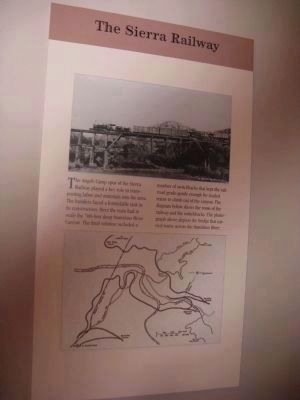
Photographed By Syd Whittle, June 13, 2010
6. Information On Display at the New Melones Reservoir Visitor Center
[Click on photo to view photo and diagram]
The diagram below shows the route of the railway and the switchbacks. The photograph above depicts the bridge that carried trains across the Stanislaus River.
Credits. This page was last revised on June 16, 2016. It was originally submitted on June 28, 2010, by Syd Whittle of Mesa, Arizona. This page has been viewed 1,305 times since then and 17 times this year. Photos: 1, 2, 3, 4, 5. submitted on June 28, 2010, by Syd Whittle of Mesa, Arizona. 6. submitted on June 29, 2010, by Syd Whittle of Mesa, Arizona.
